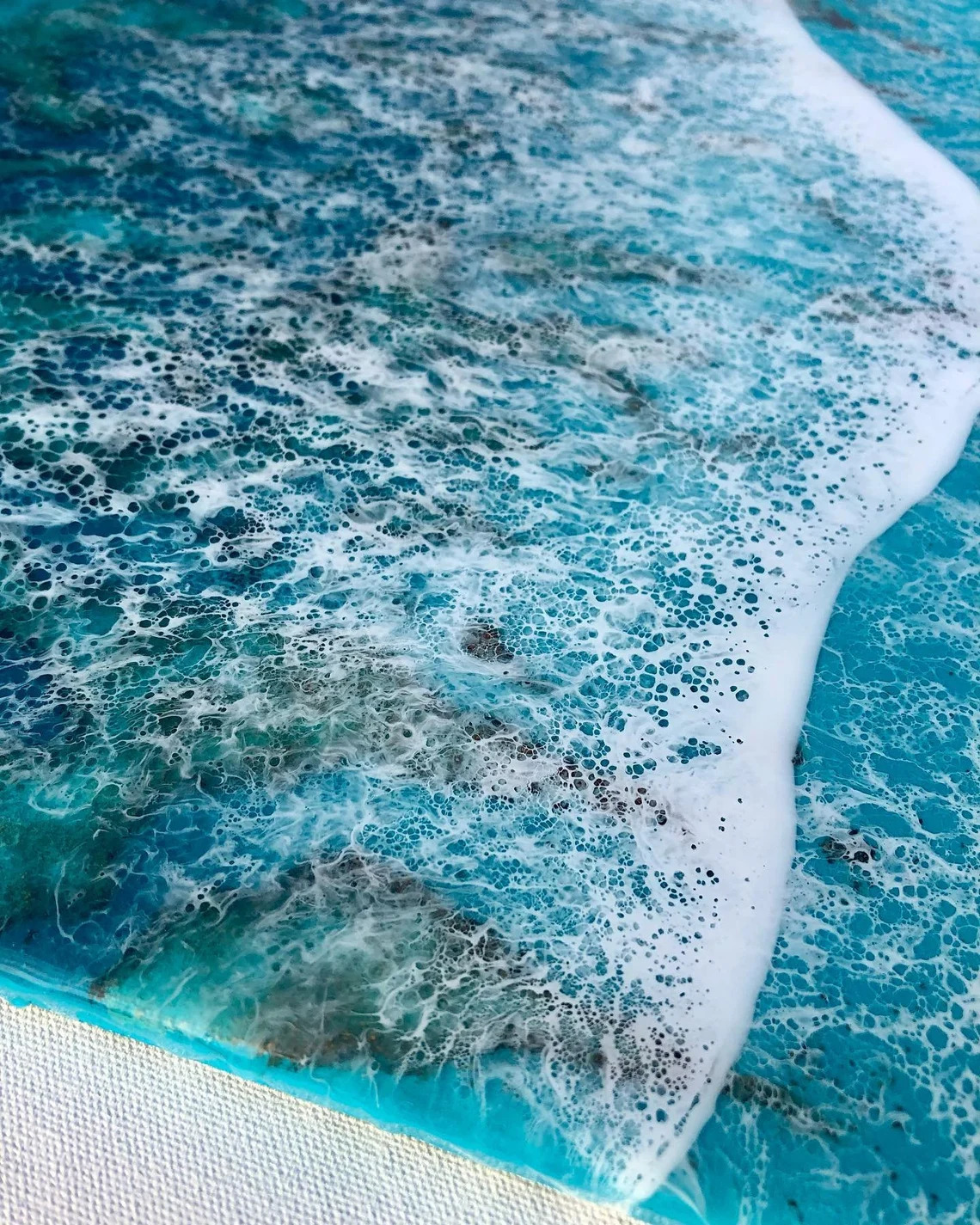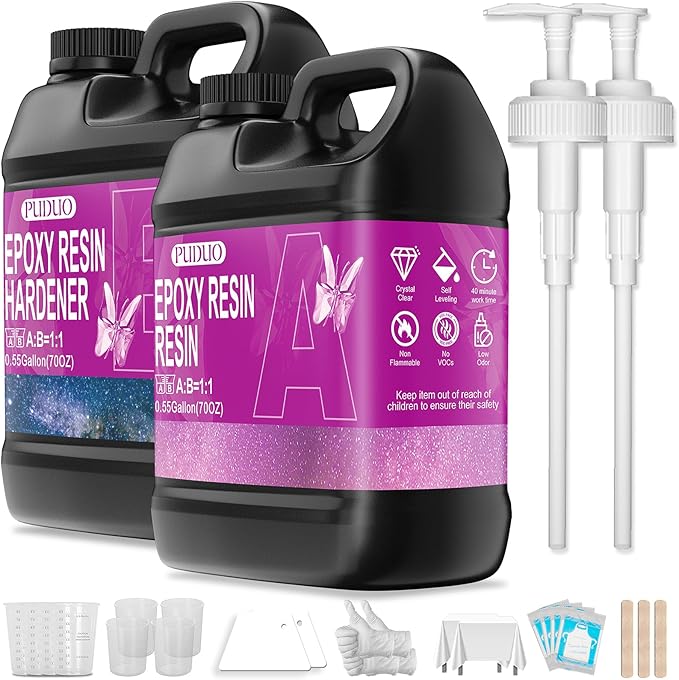Creating Stunning Resin Beach Wave Scenes: The Art of the Ocean Beach Pour
The mesmerizing effect of ocean waves effects captured in both UV and epoxy resin has become a popular trend in the world of resin art. This technique, often referred to as the resin beach wave technique, involves blending pigmented resin with heat manipulation to create realistic, foamy waves crashing onto a sandy or seashell-adorned shore. The smaller projects are more suitable for UV resin, while epoxy resin can be used for any sized project. Epoxy resin is normally chosen for its slower curing times, which in turn allows for more intricate effects.
Table of Contents
Whether you’re making coasters, serving boards, full-sized wall art, or deep pour resin river tables, mastering this method can take your resin work up quite a few notches to the next levels in this beautiful artform.

Understanding the Resin Beach Wave Technique
Before diving in, it’s helpful to experiment with colors, moving the resin and layering techniques on a small test piece. A small, not to deep circular mold would be my suggestion for this. And when working with resin and any project performing similar experiments before your final pieces is a worthwhile practice.
This allows you to understand resin consistency, heat manipulation, and wave formation before attempting a full piece. Try mixing different shades of blue, turquoise or teal or adding metallic pigments for shimmer, or incorporating clear resin for depth.
Recommended Practice Techniques for The Resin Beach Wave:
- Wave Flow: Practice using a heat gun to push white resin over blue resin to mimic real wave movement.
- Color Depth: Experiment with adding black or navy blue to create depth in deeper ocean sections.
- Transparency: Test different resin transparency levels to see how layers interact.
- Sand & Texture: Try using actual sand or textured additives for a more natural shoreline effect.
- Adding a Textured surface: Creating a textured surface on top of your first shallow layer can add great effects.
As an Amazon Associate, I earn from qualifying purchases.
This post contains affiliate links. If you buy through them, I may earn a commission at no extra cost to you.
Safety First: Working with Any Resin
Resin is a chemical compound that requires proper handling to ensure both safety and a successful outcome. Here are some key precautions:
Ventilation & Protection
- Always work in a well-ventilated space or wear a respirator to avoid inhaling fumes.
- Wear nitrile gloves to protect your skin from irritation.
- Use safety goggles when working with large resin pours to prevent splashes.
Heat & Fire Safety
- Do not overheat resin with a torch or heat gun, as excessive heat can cause bubbling or burning.
- Keep a fire extinguisher nearby if using alcohol inks or high-powered heat tools.
Proper Disposal
- Never pour excess resin down the drain; let it cure fully before disposal.
- Use silicone mats or disposable surfaces to protect workspaces.

Step-by-Step Process of the Resin Beach Wave Technique
1. Prepare Your Workspace and Gather Your Supplies
Ensure your surface is level and covered with protective material. Have all materials ready before mixing resin, as working time is limited.
- Choose your Resin, UV or epoxy
- Pigments of alcohol inks, white, blue, teal and may be sand colored
- A hair dryer or heat gun for creating wave effects
- Mixing cups, stirring sticks and weighing scales
- Your molds, food grade silicone ones are the best as epoxy resin creates heat
2. Mix Your First Layer of Resin
Follow the manufacturer’s instructions for proper resin-to-hardener ratio most are by weight. It is always best to stir slowly to minimize bubbles. Add your Blue Color and pour your ocean base into the bottom of the mold.
3. Next you Can Use Clear or Other Color Variations to Create a Gradient
- Deep blue for the ocean base.
- Turquoise or teal to create shallower water.
- White for foamy waves.
4. Pour the Resin
Layer colors from darkest to lightest, allowing some overlap for natural blending. This will create depth.
5. Next Create the Resin Beach Wave Effect.
- Mix and add a sandy colored resin mix, embed seashells, sand, or small stones or other beach embellishments. Star fish, driftwood, may be even some seaweed looking pieces.
- Let the resin set up a little.
6. Form the Wave Details
- Mix and apply white resin in thin lines where you want the waves to form.
- Use a heat gun in a sweeping motion to move the line and create a foamy, lacy effect. This takes a little work and it is best to practice first, try different angles and speeds
- Layer multiple waves for a more realistic shoreline.
Do this while resin is still tacky.
7. Now It is Time
Let It Cure At Least Overnight
Follow the manufacturer’s curing time (typically 24-48 hours) but times can vary from one manufacturer to another.
Common Q&A’s
Q: Why is my resin bubbling?
A: Air bubbles form from over-mixing or excessive heat. Try using a torch lightly or letting the resin sit for a few minutes before pouring.
Q: Can I fix mistakes after the resin cures?
A: Yes! You can make repairs, even a little sanding and then re-pouring a clear resin layer to fix imperfections.
Q: How do I prevent waves from blending too much?
A: Use less heat when pushing waves and let each layer cure slightly before adding another wave.
Q: What resin is best for the beach wave system?
A: UV resin is best for smaller projects as they fit in the average UV lamp, epoxy resin is best for the larger projects as you have more time to blend the colors and create wave effects.
If you would like more information on using resin follow this link to another post on using resins, HERE.
Conclusion
The resin beach wave technique is an exciting way to bring oceanic beauty of blues and whites into your artwork. Whether you’re a beginner or an advanced resin artist, experimenting with different pigments, layering styles, and textures can lead to incredible results. Try it out and share your own experiences!
Contact Us
We hope you found this information on resin beach wave technique helpful! If you have any questions or need assistance, feel free to reach out. Please note that due to government regulations, you’ll need to sign in and confirm your message. We apologize for any inconvenience.
Author: Rob
Ps. This is the company that taught me how to build this site and 3 others in 6 months, they keep their promises.


